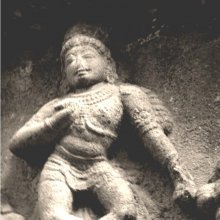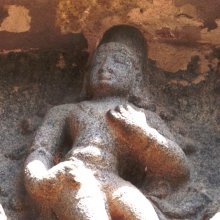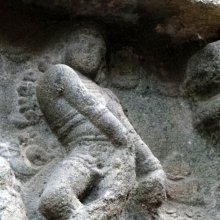Skhalita: 18 definitions
Introduction:
Skhalita means something in Buddhism, Pali, Hinduism, Sanskrit, Jainism, Prakrit, Marathi. If you want to know the exact meaning, history, etymology or English translation of this term then check out the descriptions on this page. Add your comment or reference to a book if you want to contribute to this summary article.
Images (photo gallery)
In Hinduism
Natyashastra (theatrics and dramaturgy)
Source: Wisdom Library: Nāṭya-śāstra1) Skhalita (स्खलित).—One of the 108 karaṇas (minor dance movement) mentioned in the Nāṭyaśāstra chapter 4. The instructions for this nitamba-karaṇa is as follows, “after observing Dolāpādā Cārī, hands with Recita gesture to be turned round in harmony with this.”.
A karaṇa represents a minor dance movements and combines sthāna (standing position), cārī (foot and leg movement) and nṛttahasta (hands in dancing position).
2) Skhalita (स्खलित) is the name of a meter belonging to the Śīrṣaka class described in the Nāṭyaśāstra chapter 32:—“the metre which has in its feet of twenty-four syllables, the first, the fourth, the seventh, the tenth, the eleventh and the last long, is skhalita”.
Source: Shodhganga: Elements of Art and Architecture in the Trtiyakhanda of the Visnudharmottarapurana (natya)1) Skhalita (स्खलित) or Skhalitagati refers to one of the various Gatis (“way of walking”) (in Indian Dramas), according to the Viṣṇudharmottarapurāṇa, an ancient Sanskrit text which (being encyclopedic in nature) deals with a variety of cultural topics such as arts, architecture, music, grammar and astronomy.—The word skhalita means stumbled. So, the term skhalita-gati obviously denotes irregularity in walking. The movements of the drunken person and mad man are always irregular and unstable.
2) Skhalita (स्खलित) refers to one of the 108 kinds of Karaṇa (“coordination of precise movements of legs and hands”), according to the Viṣṇudharmottarapurāṇa.—Accordingly, karaṇas are the coordination of precise movements of legs and hands performed in a particular posture. The Nāṭyaśāstra also gives its view point in the same spirit. In the Viṣṇudharmottarapurāṇa, one hundred and eight kinds of karaṇas are accepted, e.g., Skhalita.

Natyashastra (नाट्यशास्त्र, nāṭyaśāstra) refers to both the ancient Indian tradition (shastra) of performing arts, (natya—theatrics, drama, dance, music), as well as the name of a Sanskrit work dealing with these subjects. It also teaches the rules for composing Dramatic plays (nataka), construction and performance of Theater, and Poetic works (kavya).
Chandas (prosody, study of Sanskrit metres)
Source: Shodhganga: a concise history of Sanskrit Chanda literatureSkhalita (स्खलित) is the alternative name of a Sanskrit metre (chandas) mentioned by Hemacandra (1088-1173 C.E.) in his auto-commentary on the second chapter of the Chandonuśāsana. Skhalita corresponds to Mahitā, Kāntā, Vanamayūra. Hemacandra gives these alternative names for the metres by other authorities (like Bharata), even though the number of gaṇas or letters do not differ.

Chandas (छन्दस्) refers to Sanskrit prosody and represents one of the six Vedangas (auxiliary disciplines belonging to the study of the Vedas). The science of prosody (chandas-shastra) focusses on the study of the poetic meters such as the commonly known twenty-six metres mentioned by Pingalas.
Jyotisha (astronomy and astrology)
Source: Wisdom Library: Brihat Samhita by VarahamihiraSkhalita (स्खलित) or Skhalitavrata refers to “men of weak resolution”, according to the Bṛhatsaṃhitā (chapter 16) (“On the planets—graha-bhaktiyoga”), an encyclopedic Sanskrit work written by Varāhamihira mainly focusing on the science of ancient Indian astronomy astronomy (Jyotiṣa).—Accordingly, “[...] Saturn also presides over binders, bird hunters, impure men, boatmen or fishermen, ugly men and old men; over dealers in hogs, chiefs of tribes, men of weak resolution (skhalita-vrata), hill men, harbarous mountain tribes and over poor men”.

Jyotisha (ज्योतिष, jyotiṣa or jyotish) refers to ‘astronomy’ or “Vedic astrology” and represents the fifth of the six Vedangas (additional sciences to be studied along with the Vedas). Jyotisha concerns itself with the study and prediction of the movements of celestial bodies, in order to calculate the auspicious time for rituals and ceremonies.
Ayurveda (science of life)
Veterinary Medicine (The study and treatment of Animals)
Source: archive.org: The Elephant Lore of the HindusSkhalita (स्खलित) refers to the “stumbling (gait)” (of an elephant), according to the 15th century Mātaṅgalīlā composed by Nīlakaṇṭha in 263 Sanskrit verses, dealing with elephantology in ancient India, focusing on the science of management and treatment of elephants.—[Cf. chapter 9, “on kinds of must”]: “11. When his gait stumbles (skhalita-gati) for no reason, his neck droops, he is very melancholy, sighs long and gently, his trunk hangs down to the ground, his eyes close quickly, he is sleepy and his limbs are sluggish, he eats enormously and urinates frequently, that is the dangerous (kind of must)”.

Āyurveda (आयुर्वेद, ayurveda) is a branch of Indian science dealing with medicine, herbalism, taxology, anatomy, surgery, alchemy and related topics. Traditional practice of Āyurveda in ancient India dates back to at least the first millenium BC. Literature is commonly written in Sanskrit using various poetic metres.
In Buddhism
Mahayana (major branch of Buddhism)
Source: Wisdom Library: Maha Prajnaparamita SastraSkhalita (स्खलित) refers to “bodily defect”, according to Mahāprajñāpāramitāśāstra (chapter 41).—Accordingly, “[The eighteen āveṇika-dharmas (‘special attributes’)]—[...] (1-2). The Buddha has no bodily or vocal defect.—[Question].—Why does the Buddha have no bodily defect (skhalita) or vocal defect (ravita)? [Answer].—For innumerable incalculable periods the Buddha has observed purity of morality: this is why his bodily and vocal actions are faultless. The other Arhats such as Śāriputra, etc., have cultivated the precepts for less time, sixty kalpas at maximum: this is why they have faults. For innumerable incalculable periods the Buddha has accumulated and perfected the pure precepts, he has always practiced the profound concentrations, he has obtained all the marvelous knowledges and has properly cultivated the mind of great compassion: this is why he is without faults. [...]”.
Source: academia.edu: A Study and Translation of the GaganagañjaparipṛcchāSkhalita (स्खलित) refers to “error”, according to the Gaganagañjaparipṛcchā: the eighth chapter of the Mahāsaṃnipāta (a collection of Mahāyāna Buddhist Sūtras).—Accordingly, “Then the Bodhisattva Gaganagañja, having praised the Lord with these verses, addressed himself to the Lord: ‘[...] Since the Lord has obtained intrepidities, extinguished contamination, was perfectly awakened to sameness (samatā), is skilled in the knowledge of purification without affliction, and roars the best of lions’ roar to all of the world including the gods. Since the Lord is endowed with the eighteen special qualities of the Buddha, he has the unattached knowledge of the three times (trikāla). Since the Lord has purified his body, speech, and mind, he has neither error (skhalita) nor rough speech (ravita), and sees every concentration (samāpatti) and the knowledge of liberation. [...]’”.

Mahayana (महायान, mahāyāna) is a major branch of Buddhism focusing on the path of a Bodhisattva (spiritual aspirants/ enlightened beings). Extant literature is vast and primarely composed in the Sanskrit language. There are many sūtras of which some of the earliest are the various Prajñāpāramitā sūtras.
In Jainism
General definition (in Jainism)
Source: The University of Sydney: A study of the Twelve ReflectionsSkhalita (स्खलित) refers to the “tottering” (of the world), according to the 11th century Jñānārṇava, a treatise on Jain Yoga in roughly 2200 Sanskrit verses composed by Śubhacandra.—Accordingly, “This world totters to the limit of the world of Brahmā with the fear of the beginning of a frown, and mountains immediately fall asunder by force of [the fact that] the earth is overcome by the weight of the heavy feet, of those heroes [com.—this (idaṃ) world (jagat) is tottering (skhalitaṃ), trembling (cakitam)] who are all led to death by the king of time in [the space of] some days. Nevertheless, desire is intense only in a living being who is bereft of sense”.

Jainism is an Indian religion of Dharma whose doctrine revolves around harmlessness (ahimsa) towards every living being. The two major branches (Digambara and Svetambara) of Jainism stimulate self-control (or, shramana, ‘self-reliance’) and spiritual development through a path of peace for the soul to progess to the ultimate goal.
Languages of India and abroad
Marathi-English dictionary
Source: DDSA: The Molesworth Marathi and English Dictionaryskhalita (स्खलित).—p (S) That has stumbled or tripped. 2 Dropped, dripped, fallen more generally. 3 (For rētaskhalita) Cui semen emissum. 4 Erred or erring (in speech, in moral action &c.)
Source: DDSA: The Aryabhusan school dictionary, Marathi-Englishskhalita (स्खलित).—p That has stumbled. Dropped; erred.
--- OR ---
skhalita (स्खलित).—a Dropped.
Marathi is an Indo-European language having over 70 million native speakers people in (predominantly) Maharashtra India. Marathi, like many other Indo-Aryan languages, evolved from early forms of Prakrit, which itself is a subset of Sanskrit, one of the most ancient languages of the world.
Sanskrit dictionary
Source: DDSA: The practical Sanskrit-English dictionarySkhalita (स्खलित).—p. p. [skhal-kta]
1) Stumbled, slipped, tripped,
2) Fallen, dropped down.
3) Shaking, wavering, fluctuating, unsteady.
4) Intoxicated, drunk.
5) Stammering, faltering; सबाष्पकण्ठस्खलितैः पदैरियम् (sabāṣpakaṇṭhaskhalitaiḥ padairiyam) Kumārasambhava 5.56.
6) Agitated, disturbed.
7) Erring, blundering; सर्वत्र स्खलितेषु दत्तमनसा यातं मया नोद्धतम् (sarvatra skhaliteṣu dattamanasā yātaṃ mayā noddhatam) Ve.2.1.
8) Dropped, emitted.
9) Dripping, trickling down.
1) Interrupted, stopped.
11) Confounded.
12) Gone.
13) Wounded; यद्यत्र स्खलितं गात्रं तत्र दम्भं प्रपातयेत् (yadyatra skhalitaṃ gātraṃ tatra dambhaṃ prapātayet) Śukra.4.97.
14) Incomplete, deficient.
-tam 1 Stumbling, tripping, a fall.
2) Deviation from the right course.
3) Error, blunder, mistake; गोत्रस्खलित (gotraskhalita) Kumārasambhava 4.8.
4) Fault, sin, transgression.
5) Deceit, treachery.
6) Circumvention, stratagem.
7) Loss, deprivation.
Source: Cologne Digital Sanskrit Dictionaries: Shabda-Sagara Sanskrit-English DictionarySkhalita (स्खलित).—mfn.
(-taḥ-tā-taṃ) 1. Slipped, fallen. 2. Gone. 3. Shaken, agitated, disturbed. 4. Shaking, wavering, unsteady, (literally or figuratively.) 5. Drunk. 6. Stuttering, hesitating, (in speech.) 7. Dropped, effused, emitted. 8. Trickling down. 9. Interrupted, stopped. 10. Confounded. n.
(-taṃ) 1. Circumvention, stratagem, (in war.) 2. Falling, tumbling. 3. Falling or deviating from virtue or truth. 4. Fault, error, sin. 5. Deceit, treachery. E. skhal to go, aff. kta .
Source: Cologne Digital Sanskrit Dictionaries: Cappeller Sanskrit-English DictionarySkhalita (स्खलित).—[neuter] the same; blunder, fault, error, loss.
Source: Cologne Digital Sanskrit Dictionaries: Monier-Williams Sanskrit-English Dictionary1) Skhalita (स्खलित):—[from skhal] mfn. stumbling, tripping, unsteady (as a gait), [Mahābhārata; Kāvya literature] etc.
2) [v.s. ...] dropping falling, dripping, trickling down, [Mālatīmādhava]
3) [v.s. ...] intoxicated, drunk, [Horace H. Wilson]
4) [v.s. ...] stammering, faltering (speech), [Kāvya literature; Kathāsaritsāgara]
5) [v.s. ...] stopped, checked, obstructed, impeded, interrupted, frustrated, baffled, [Kāvya literature; Pañcatantra; Bhāgavata-purāṇa]
6) [v.s. ...] confounded, perplexed by ([instrumental case]), [Śiśupāla-vadha]
7) [v.s. ...] incomplete, deficient (opp. to ulbaṇa), [Śāṅkhāyana-brāhmaṇa]
8) [v.s. ...] erring, failing, blundering in ([locative case]), [Śakuntalā]
9) [v.s. ...] awkward about ([locative case]), [Varāha-mihira’s Bṛhat-saṃhitā]
10) [v.s. ...] n. the act of tripping, stumbling, staggering, [Mahābhārata; Rāmāyaṇa] etc.
11) [v.s. ...] mistake, error, failure, blunder, blundering in ([locative case] or [compound]), [ib.]
12) [v.s. ...] loss, deprivation, [Ratnāvalī]
13) [v.s. ...] circumvention, stratagem (in war), [cf. Lexicographers, esp. such as amarasiṃha, halāyudha, hemacandra, etc.]
Source: Cologne Digital Sanskrit Dictionaries: Yates Sanskrit-English DictionarySkhalita (स्खलित):—[(taḥ-tā-taṃ) a.] Slipped, gone, unsteady. n. Circumvention; falling; shaken, shaking.
Source: DDSA: Paia-sadda-mahannavo; a comprehensive Prakrit Hindi dictionary (S)Skhalita (स्खलित) in the Sanskrit language is related to the Prakrit words: Khalia, Chalia.
Sanskrit, also spelled संस्कृतम् (saṃskṛtam), is an ancient language of India commonly seen as the grandmother of the Indo-European language family (even English!). Closely allied with Prakrit and Pali, Sanskrit is more exhaustive in both grammar and terms and has the most extensive collection of literature in the world, greatly surpassing its sister-languages Greek and Latin.
Kannada-English dictionary
Source: Alar: Kannada-English corpusSkhalita (ಸ್ಖಲಿತ):—
1) [adjective] stumbling; faltering.
2) [adjective] slipping; skidding; sliding.
3) [adjective] shivering; trembling.
4) [adjective] misdone; wrongly done.
5) [adjective] holding back from indecision; hesitating; vacillating.
6) [adjective] trickled; dripped; dribbled.
7) [adjective] obstructed; hindered; stopped.
8) [adjective] gone astray.
--- OR ---
Skhalita (ಸ್ಖಲಿತ):—
1) [noun] a mistake; a wrong deed; a blunder.
2) [noun] the act of cheating; an instance of cheating or being cheated.
3) [noun] a secret plan to achieve an unlawful end; an underhand plot; an evil design; machination.
4) [noun] a man who is trembling from fear.
5) [noun] (dance.) a particular movement in which one leg is lifted and swung with the front portion of the foot raised, and the heel is placed on ground and moving one arm correspondingly, holding the little finger stretched upward, other three fingers stretched and bent forward and thumb held close to the forefinger.
6) [noun] (dance.) a breathing hard (as from sorrow, disease or while dying).
--- OR ---
Skhaḷita (ಸ್ಖಳಿತ):—[adjective] = ಸ್ಖಲಿತ [skhalita]1.
--- OR ---
Skhaḷita (ಸ್ಖಳಿತ):—[noun] = ಸ್ಖಲಿತ [skhalita]2.
Kannada is a Dravidian language (as opposed to the Indo-European language family) mainly spoken in the southwestern region of India.
Nepali dictionary
Source: unoes: Nepali-English DictionarySkhalita (स्खलित):—adj. 1. marred; defective; corrupt (as a manuscript reading); 2. erring (from right course); 3. discharged (semen);
Nepali is the primary language of the Nepalese people counting almost 20 million native speakers. The country of Nepal is situated in the Himalaya mountain range to the north of India.
See also (Relevant definitions)
Starts with: Skhalitagati, Skhalitamtaramga, Skhalitasubhagam, Skhalitavacana, Skhalitavat, Skhalitavibhrama, Skhalitavirya, Skhalitavrata, Skhaliteshta.
Query error!
Full-text (+59): Askhalita, Skhalitagati, Pariskhalita, Skhalitasubhagam, Praskhalita, Samskhalita, Bhavaskhalita, Skhal, Gotraskhalita, Pratiskhalita, Madaskhalita, Skhaliteshta, Skhalitavirya, Skhalitavat, Virodhaskhalita, Askhalitaprayana, Viskhalita, Ashakuna, Skalitam, Manahskhalita.
Relevant text
Search found 19 books and stories containing Skhalita, Skhaḷita; (plurals include: Skhalitas, Skhaḷitas). You can also click to the full overview containing English textual excerpts. Below are direct links for the most relevant articles:
Bhajana-Rahasya (by Srila Bhaktivinoda Thakura Mahasaya)
Text 20 < [Chapter 5 - Pañcama-yāma-sādhana (Aparāhna-kālīya-bhajana–kṛṣṇa-āsakti)]
Text 19 < [Chapter 3 - Tṛtīya-yāma-sādhana (Pūrvāhna-kālīya-bhajana–niṣṭhā-bhajana)]
Brihat Jataka by Varahamihira [Sanskrit/English] (by Michael D Neely)
Verse 18.17 < [Chapter 19 - Results of the Aspects]
Maha Prajnaparamita Sastra (by Gelongma Karma Migme Chödrön)
I. Refutation of the first Sarvāstivādin list < [Part 2 - Refutation of the Sarvāstivādin theories on the special attributes]
I. Text of the list according to the Prajñāpāramitā < [Part 1 - Mahāyānist list of the eighteen special attributes of the Buddha]
Preliminary note (1): The eighteen āveṇikadharmas of the Buddhas < [Chapter XLI - The Eighteen Special Attributes of the Buddha]
Bhakti-rasamrta-sindhu (by Śrīla Rūpa Gosvāmī)
Verse 2.4.37 < [Part 4 - Transient Ecstatic Disturbances (vyābhicāri-bhāva)]
Verse 2.4.36 < [Part 4 - Transient Ecstatic Disturbances (vyābhicāri-bhāva)]
Notices of Sanskrit Manuscripts (by Rajendralala Mitra)
Chaitanya Bhagavata (by Bhumipati Dāsa)
Verse 3.5.627 < [Chapter 5 - The Pastimes of Nityānanda]
Verse 3.1.181 < [Chapter 1 - Meeting Again at the House of Śrī Advaita Ācārya]


